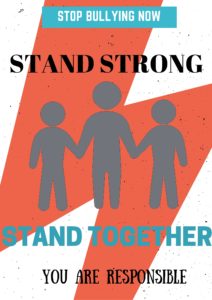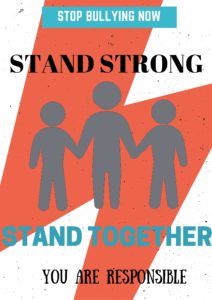In order to better understand bullying and intervention from a kids perspective I interviewed 13 school aged children. They were elementary, middle, and high school students. The first question I asked them was what is bullying. They all identified bullying as harmful behavior that one person does to another. Some specified that it could include either physical or verbal abuse and most said that it was something that happened repeatedly. Over half of them had seen bullying or had been bullied themselves.
Next, I asked what they saw adults doing about bullying. Almost all of the children said teachers do step in and help and often kids are sent to the guidance counselor or the principle’s office but a few said they did not take it seriously enough. A high schooler noted that teachers seem to take a less active role in intervening with kids in high school than they did in middle or elementary school. Her thought was that adults assumed that high schoolers should know how to deal with it by now but she expressed that many of them do not and that they still need help from adults.
When asked if kids had a job in stopping bullying nearly all of the children said “yes”. The ways they said kids should help is to step in and tell the bully to stop or tell a teacher. Or if they are being bullied themselves they should just ignore it. Of those who weren’t really sure what the kids job was one said they didn’t know what to do to stop it and one said she never gets involved if she sees bullying because she is afraid. One spoke very highly of peer intervention and said he thought kids could probably do a better job of handling a bullying incident than adults because they can just tell the kid to “knock it off” and that usually stops the problem quickly. Over half of the kids said they have stepped in on behalf of another being bullied, either by telling the bully to stop, talking it out with the two involved or telling a teacher. Six of them specifically said their intervention stopped the bullying behavior in that particular instance. However, one girl pointed out that not everyone stands up for themselves or for others being bullied. She says it takes a strong, confident person to do it. There are kids who don’t have this inner strength and that is evident in the one girl who said she never gets involved when she sees bullying because she is afraid the bully will attack her, and another girl who said she is often reluctant to step in because not only could you make the bully mad but all of their friends too.
Bullying in today’s school systems have been drastically affected by the increasing actions of bystandards. In a recent study done by the University of Turku in Finland, it was found that the most consistant way to reduce or even completely stop a child from being bullied is bystandards intervening for other children. It is found to work so well in the dissolvement of bullying because not only does it give confidnece and a sense of protection to the child being bullied, but it also allows the bully to see what he/she is doing wrong. Going back on what i talked about earlier, education is key to young kids. Once children understand that bullying is wrong and see what is looks like, they will be able to stop the problem at the source and stop any other kids from getting bullied also.
The next question was, could adults be doing anything more to help. The majority said they thought adults should intervene and take care of the problem right as it is happening; too often it doesn’t get addressed right away. One suggested that teachers should take the two parties aside and talk it out with them. Another thought there should be more supervision at recess and and in the halls; places where bullying usually occurs.
Finally, I asked who’s job they thought it was to stop bullying. I got an array of answers: parents of the bullly, teachers, the bully, the one being bullied, peers and 2 said it was everyones job. I think these answers show that kids can see there are many people involved in the issue. Kids can help at times but they need all the adults around them to help too. That is why it is important to send the message that everyone plays a role in stopping this problem and everyone has to be active to make a difference.
The poster is an image of people holding hands with writing that says “Stop Bullying. Stand Strong Stand Together.” This shows that bullying is an important issue that has yet to be solved. “Stand Strong Stand Together” offers a solution to bullying by sticking up for each other and everyone being involved. The people holding hands are different sizes because it is not just students that must stick up for each other and stop bullying but it is parents, teachers, students, and the community alike to stick together to be stronger than a bully. This poster is really trying to target everyone that we are friends with on social media. Past teachers, family members, peers, and younger compatriots that we have encountered. We hope this will leave a lasting impact on them to show that people who are bullied are not alone and that just sticking together to solve the bullying problem can be the best solution.
telling stories, hearing lives
© 2026 Cultures of Engagement
Theme by Anders Noren — Up ↑



Recent Comments